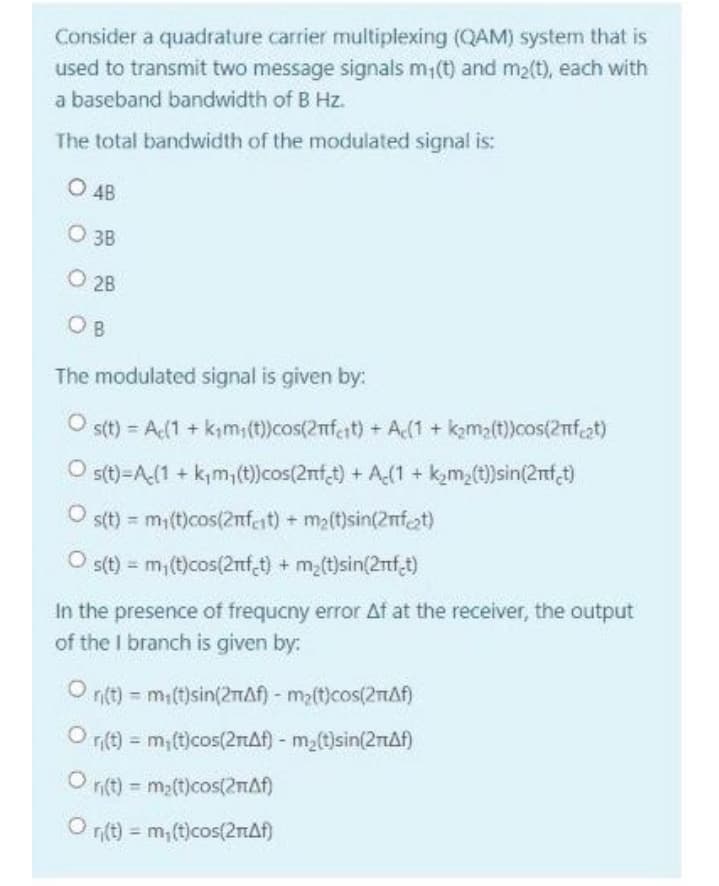Consider a quadrature carrier multiplexing (QAM) system that is used to transmit two message signals m;(t) and m2(t), each with a baseband bandwidth of B Hz. The total bandwidth of the modulated signal is: O 4B O 3B O 28 OB The modulated signal is given by: s(t) = A(1 + kım;(t))cos(2nfeit) + A(1 + kama(t)cos(2nfcat) O s(t)=A(1 + k,m,(t))cos(2nf,t) + A(1 + k,m,(t)sin(2nf,t) s(t) = mi(t)cos(2nfeit) + ma(t)sin(2nfat) s(t) = m,(t)cos(2nf,t) + m (t)sin(2rtf,t) %3D In the presence of frequcny error Af at the receiver, the output of the I branch is given by: O nit) = m;(t)sin(2mAf) - ma(t)cos(2nAf) O r(t) = m,(t)cos(2nAf) - m2(t)sin(2nAf) %3D n(t) = m2(t)cos(2Af) O r(t) = m,(t)cos(2nAf)
Consider a quadrature carrier multiplexing (QAM) system that is used to transmit two message signals m;(t) and m2(t), each with a baseband bandwidth of B Hz. The total bandwidth of the modulated signal is: O 4B O 3B O 28 OB The modulated signal is given by: s(t) = A(1 + kım;(t))cos(2nfeit) + A(1 + kama(t)cos(2nfcat) O s(t)=A(1 + k,m,(t))cos(2nf,t) + A(1 + k,m,(t)sin(2nf,t) s(t) = mi(t)cos(2nfeit) + ma(t)sin(2nfat) s(t) = m,(t)cos(2nf,t) + m (t)sin(2rtf,t) %3D In the presence of frequcny error Af at the receiver, the output of the I branch is given by: O nit) = m;(t)sin(2mAf) - ma(t)cos(2nAf) O r(t) = m,(t)cos(2nAf) - m2(t)sin(2nAf) %3D n(t) = m2(t)cos(2Af) O r(t) = m,(t)cos(2nAf)
Introductory Circuit Analysis (13th Edition)
13th Edition
ISBN:9780133923605
Author:Robert L. Boylestad
Publisher:Robert L. Boylestad
Chapter1: Introduction
Section: Chapter Questions
Problem 1P: Visit your local library (at school or home) and describe the extent to which it provides literature...
Related questions
Question

Transcribed Image Text:Consider a quadrature carrier multiplexing (QAM) system that is
used to transmit two message signals m;(t) and m2(t), each with
a baseband bandwidth of B Hz.
The total bandwidth of the modulated signal is:
O 4B
O 3B
O 2B
O B
The modulated signal is given by:
s(t) = A(1 + kım;(t))cos(2nfeit) + A(1 + kama(t))cos(2nfat)
O s(t)=A(1 + k,m,(t)cos(2nft) + A(1 + k,m,(t)sin(2nf,t)
s(t) = mi(t)cos(2nfeit) + ma(t)sin(2nfat)
%3D
s(t) = m,(t)cos(2nf t) + m(t)sin(2nf,t)
%3!
In the presence of frequcny error At at the receiver, the output
of the I branch is given by:
O nt) = mi(t)sin(2mAf) - ma(t)cos(2nAf)
O r(t) = m;(t)cos(2TAF) - m2(t)sin(2rAf)
n(t) m2(t)cos(2nAf)
n(t) = m; (t)cos(21AN)
Expert Solution
This question has been solved!
Explore an expertly crafted, step-by-step solution for a thorough understanding of key concepts.
This is a popular solution!
Trending now
This is a popular solution!
Step by step
Solved in 3 steps with 3 images

Knowledge Booster
Learn more about
Need a deep-dive on the concept behind this application? Look no further. Learn more about this topic, electrical-engineering and related others by exploring similar questions and additional content below.Recommended textbooks for you

Introductory Circuit Analysis (13th Edition)
Electrical Engineering
ISBN:
9780133923605
Author:
Robert L. Boylestad
Publisher:
PEARSON

Delmar's Standard Textbook Of Electricity
Electrical Engineering
ISBN:
9781337900348
Author:
Stephen L. Herman
Publisher:
Cengage Learning

Programmable Logic Controllers
Electrical Engineering
ISBN:
9780073373843
Author:
Frank D. Petruzella
Publisher:
McGraw-Hill Education

Introductory Circuit Analysis (13th Edition)
Electrical Engineering
ISBN:
9780133923605
Author:
Robert L. Boylestad
Publisher:
PEARSON

Delmar's Standard Textbook Of Electricity
Electrical Engineering
ISBN:
9781337900348
Author:
Stephen L. Herman
Publisher:
Cengage Learning

Programmable Logic Controllers
Electrical Engineering
ISBN:
9780073373843
Author:
Frank D. Petruzella
Publisher:
McGraw-Hill Education

Fundamentals of Electric Circuits
Electrical Engineering
ISBN:
9780078028229
Author:
Charles K Alexander, Matthew Sadiku
Publisher:
McGraw-Hill Education

Electric Circuits. (11th Edition)
Electrical Engineering
ISBN:
9780134746968
Author:
James W. Nilsson, Susan Riedel
Publisher:
PEARSON

Engineering Electromagnetics
Electrical Engineering
ISBN:
9780078028151
Author:
Hayt, William H. (william Hart), Jr, BUCK, John A.
Publisher:
Mcgraw-hill Education,